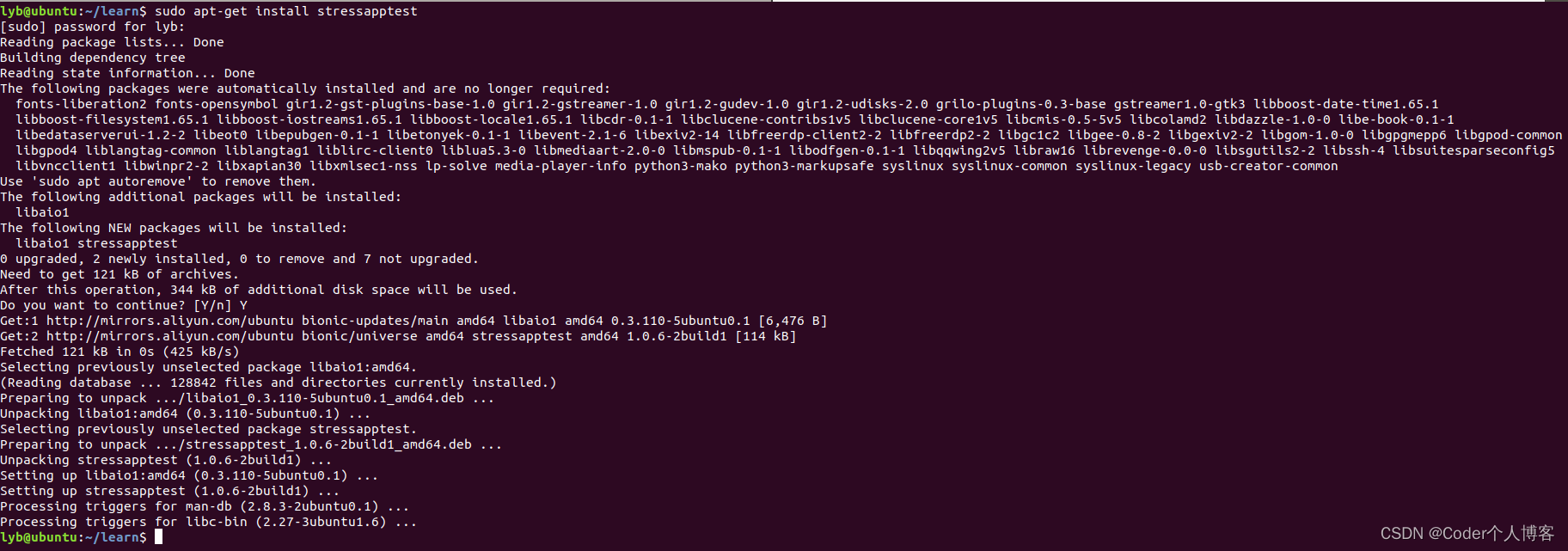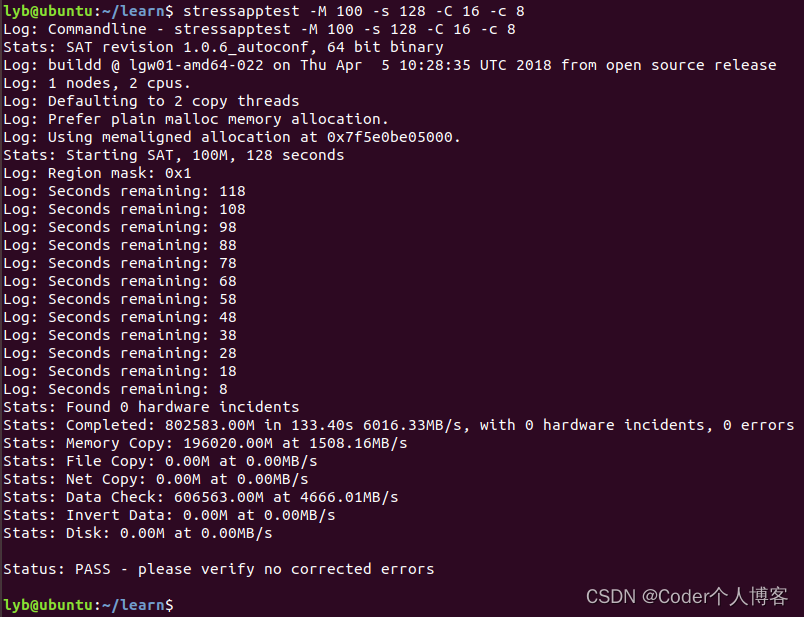文章目录
- 一、概述
- 二、安装
- 2.1、源码编译安装
- 2.2、命令行安装
- 2.3、安装确认
- 三、重要参数详解
- 3.1、查询支持的参数
- 3.2、参数说明
- 四、实例
- 4.1、随机测试(默认模式)
- 4.2、循环测试
- 4.2、全内存测试
团队博客: 汽车电子社区
一、概述
stressapptest是一款免费的开源软件,支持用于测试Linux系统的稳定性和可靠性。它可以利用多个CPU/Core,甚至可以访问主内存的所有部分来测试系统的稳定性,以此推断系统是否存在内存泄漏或其他性能方面的问题。
stressapptest的主要目标是发现难以重现的系统稳定性问题和其他体现在Java虚拟机、KVM Hypervisor和Hadoop集群等普通用例中的Linux系统中的性能问题。它还包括多个测试模式和选项以支持不同测试场景,比如随机测试、循环测试、全内存测试、持续测试等。
二、安装
2.1、源码编译安装
// 1.下载源码
git clone https://github.com/stressapptest/stressapptest.git
cd stressapptest
./configure
make
sudo make install
2.2、命令行安装
Ubuntu下执行如下命令进行安装:
sudo apt-get install stressapptest

2.3、安装确认
执行如下命令来确认stressapptest 是否安装成功:
stressapptest -h
lyb@ubuntu:~/learn$ stressapptest -h
Stats: SAT revision 1.0.6_autoconf, 64 bit binary
Log: buildd @ lgw01-amd64-022 on Thu Apr 5 10:28:35 UTC 2018 from open source release
Usage: ./sat(32|64) [options]-M mbytes megabytes of ram to test-H mbytes minimum megabytes of hugepages to require-s seconds number of seconds to run-m threads number of memory copy threads to run-i threads number of memory invert threads to run-C threads number of memory CPU stress threads to run--findfiles find locations to do disk IO automatically-d device add a direct write disk thread with block device (or file) 'device'-f filename add a disk thread with tempfile 'filename'-l logfile log output to file 'logfile'--max_errors n exit early after finding 'n' errors-v level verbosity (0-20), default is 8-W Use more CPU-stressful memory copy-A run in degraded mode on incompatible systems-p pagesize size in bytes of memory chunks--filesize size size of disk IO tempfiles-n ipaddr add a network thread connecting to system at 'ipaddr'--listen run a thread to listen for and respond to network threads.--no_errors run without checking for ECC or other errors--force_errors inject false errors to test error handling--force_errors_like_crazy inject a lot of false errors to test error handling-F don't result check each transaction--stop_on_errors Stop after finding the first error.--read-block-size size of block for reading (-d)--write-block-size size of block for writing (-d). If not defined, the size of block for writing will be defined as the size of block for reading--segment-size size of segments to split disk into (-d)--cache-size size of disk cache (-d)--blocks-per-segment number of blocks to read/write per segment per iteration (-d)--read-threshold maximum time (in us) a block read should take (-d)--write-threshold maximum time (in us) a block write should take (-d)--random-threads number of random threads for each disk write thread (-d)--destructive write/wipe disk partition (-d)--monitor_mode only do ECC error polling, no stress load.--cc_test do the cache coherency testing--cc_inc_count number of times to increment the cacheline's member--cc_line_count number of cache line sized datastructures to allocate for the cache coherency threads to operate--paddr_base allocate memory starting from this address--pause_delay delay (in seconds) between power spikes--pause_duration duration (in seconds) of each pause--local_numa choose memory regions associated with each CPU to be tested by that CPU--remote_numa choose memory regions not associated with each CPU to be tested by that CPU--interleave_size bytes size in bytes of each channel's data as interleaved between memory channels--channel_width bits width in bits of each memory channel--memory_channel u1,u2 defines a comma-separated list of namesfor dram packages in a memory channel.Use multiple times to define multiple channels.
lyb@ubuntu:~/learn$ 三、重要参数详解
3.1、查询支持的参数
执行如下命令来确认stressapptest支持的参数:
stressapptest -h
lyb@ubuntu:~/learn$ stressapptest -h
Stats: SAT revision 1.0.6_autoconf, 64 bit binary
Log: buildd @ lgw01-amd64-022 on Thu Apr 5 10:28:35 UTC 2018 from open source release
Usage: ./sat(32|64) [options]-M mbytes megabytes of ram to test-H mbytes minimum megabytes of hugepages to require-s seconds number of seconds to run-m threads number of memory copy threads to run-i threads number of memory invert threads to run-C threads number of memory CPU stress threads to run--findfiles find locations to do disk IO automatically-d device add a direct write disk thread with block device (or file) 'device'-f filename add a disk thread with tempfile 'filename'-l logfile log output to file 'logfile'--max_errors n exit early after finding 'n' errors-v level verbosity (0-20), default is 8-W Use more CPU-stressful memory copy-A run in degraded mode on incompatible systems-p pagesize size in bytes of memory chunks--filesize size size of disk IO tempfiles-n ipaddr add a network thread connecting to system at 'ipaddr'--listen run a thread to listen for and respond to network threads.--no_errors run without checking for ECC or other errors--force_errors inject false errors to test error handling--force_errors_like_crazy inject a lot of false errors to test error handling-F don't result check each transaction--stop_on_errors Stop after finding the first error.--read-block-size size of block for reading (-d)--write-block-size size of block for writing (-d). If not defined, the size of block for writing will be defined as the size of block for reading--segment-size size of segments to split disk into (-d)--cache-size size of disk cache (-d)--blocks-per-segment number of blocks to read/write per segment per iteration (-d)--read-threshold maximum time (in us) a block read should take (-d)--write-threshold maximum time (in us) a block write should take (-d)--random-threads number of random threads for each disk write thread (-d)--destructive write/wipe disk partition (-d)--monitor_mode only do ECC error polling, no stress load.--cc_test do the cache coherency testing--cc_inc_count number of times to increment the cacheline's member--cc_line_count number of cache line sized datastructures to allocate for the cache coherency threads to operate--paddr_base allocate memory starting from this address--pause_delay delay (in seconds) between power spikes--pause_duration duration (in seconds) of each pause--local_numa choose memory regions associated with each CPU to be tested by that CPU--remote_numa choose memory regions not associated with each CPU to be tested by that CPU--interleave_size bytes size in bytes of each channel's data as interleaved between memory channels--channel_width bits width in bits of each memory channel--memory_channel u1,u2 defines a comma-separated list of namesfor dram packages in a memory channel.Use multiple times to define multiple channels.
lyb@ubuntu:~/learn$ 3.2、参数说明
选项说明:
-s或–timeout: 指定测试运行的总时间,以秒为单位。默认值为0(无限制)。
-M或–vm-bytes: 指定应用程序所需的内存量,以字节、千字节、兆字节或吉字节为单位。例如,“-M 2048m”表示分配2GB的内存。默认值为0(自动计算)。
-m或–vm-pattern: 指定要使用的内存模式,如线性、随机、步进等。默认值为“linear”(线性)。
-c或–cpu-cores: 指定要使用的CPU核心数。例如,“-c 4”将在四个核心上运行测试。默认值为0(使用所有可用核心)。
–affinity: 将应用程序绑定到指定的CPU核心上,以避免跨核心调度带来的额外开销。例如,“–affinity 0,2,4”将绑定应用程序到第1、3和5个CPU核心上。
–matrix: 启用矩阵测试模式,该模式可以对整个系统进行更全面的测试,并且需要更长时间才能完成。
–quiet: 禁止输出详细信息和统计数据,只显示结果摘要信息。
–log-level: 设置日志级别,以控制输出详细程度。可选值为”debug”、”info”、”warning”、”error”和”critical”。
–log-file: 将日志输出到指定的文件中,而不是标准输出。
–version: 显示stressapptest版本信息并退出。
四、实例
4.1、随机测试(默认模式)
随机模式是stressapptest的默认模式,它会随机访问系统内存中的所有部分来测试系统的稳定性。可以通过以下命令启动:
stressapptest

4.2、循环测试
循环模式是stressapptest的另一种模式,它会在指定的时间内不断迭代相同的内存模式。可以使用以下命令启动:
stressapptest -M 100 -s 128 -C 16 -c 8

4.2、全内存测试
全内存模式会尝试占用所有可用的空闲内存。可以使用以下命令启动:



![[每日一题] 01.27 - 斐波那契数列](http://pic.xiahunao.cn/[每日一题] 01.27 - 斐波那契数列)

express框架)
)
)

)



)
)



:1971. 寻找图中是否存在路径)

-----操作系统进程相关)